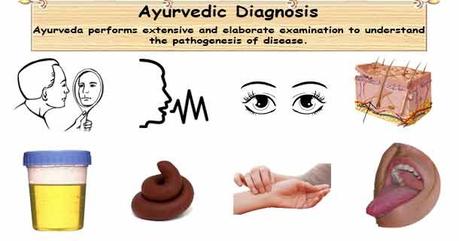
INTRODUCTION
Ayurveda is based on the sound principles of diagnosis. It does not require clinical or costly investigations. Ashtvidha pariksha is mentioned by Acharya Yogaratnakara.
Ashtashana pareeksha is one among the different methods of rogi pareeksha there are 8 factors that are taken into consideration during the examination and tests carried out with the patients. Also, Nadi Pariksha is one of the most significant examination parts for diagnosis of the disease of patients.
ASHTVIDHA PARIKSHA
- Nadi – The pulse
- Mootram – The urine
- Malam – The facal matter
- Jihwa – The tongue
- Shabda – The voice of patients
- Sparsha – Touch
- Druk – The eyes and vision
- Akruti – General body build
1. NADI PARIKSHA
Nadi apriksha is one of the most important methods of diagnosis in Ayurveda. Many physicians can make the diagnosis only by examining the pulse. The examination of strength, rhythm, speed, quality of the Nadi shows each change occurring in the body, just similar to the strings of Veena which produce music.
SYNONYMS:-
- Dhamani
- Tantuki
- Snayu
- Jeevanajnaana
TYPES OF NADI:-
- Vata Nadi – it is fast, irregular, moves like a snake. In modern science it can be compared with thread and irregular pulse. It can be felt in the Agra bhaga ie. By index finger
- Pita Nadi – in this pulse is throbbing, rich, forceful and elevated in middle. It can be compared to the jumping frog. It can be felt by middle finger
- Kapha Nadi – kapha pulse is slow, steady and somewhat heavy. Kapha nadi can be compared to the movement of a stork. It can be felt by ring finger (Anamika Anguli).
PROCEDURE:-
- The best time for naadi pareeksha is in the morning.
- Both vaidya and rogi should have calm and cool mind.
- They must sit in a comfortable – place facing each other.
- The naadi of the right hand will be clear in males, while in female that of left hand.
- The patient’s wrist should be partially flexed and extended fingers
- Physician should hold the wrist of the patient by the examining hand and should place his index, middle and ring fingers one angula below the Angushtamoola & then must examine the naadi.
- The index finger should be nearer to the root of the thumb.
NADI IN VARIOUS DISEASES: –
- Jwara – Pulse is hot and rapid in fever.
- Kaama and krodha – Pulse rate increases during lust and anger.
- Chinta and bhaya – Pulse rate decreases during worry and fear.
- Mandagni and dhatukshaya – Slow and feeble type.
- Hunger – During hunger nadi becomes unsteady and after meal it becomes stable.
2. MUTRA PARIKSHA
The urine examination is done by naked eye to check for its color, frequency, consistency and sediments. Urine is an important waste product of the body and its examination yields valuable information regarding health and ill health.
PROPERTIES OF URINE
- Ishat Peetavarnam
- Apicchilam (Non-Greasy)
- Anavilam (Clear)
- Ushna, Thikshna and Kshara
METHOD OF COLLECTION
- The mootra should be collected during the last prahara of night (early morning).
- It must be collected in a clean glass vessel and examined after sunrise.
- The middle stream is collected and initially expelled urine is expelled.
COLOUR IN VARIOUS DISEASES
- Agnimandya – Matulungarasa
- Ajeerna – Tandulodaka
- Vatapittaprakopa – Dhumrajalabha
- Vatakapha Prakopa – Phenila and Sweta
- Kaphapittaprakopa – Rakthavarna and Kalusha
TAILA BINDU PARIKSHA
Tailabindu pariksha is a diagnostic tool of urine examination developed by the Acharya Yogaratnakar. Taila bindu pareeksha on mutra of different individual is used to determine the sadyaasadyata of a disease.
One drop of pure sesame oil is put over a cup of freshly collected urine, then note its spread:
- Spread towards varuni direction-good prognosis
- Southwards, agneya, vayavya, nairitya-bad prognosis
- Shape indicating good prognosis Lotus, jasmine, swan, pond, elephant, mountain, palace, tree
- Shape indicating bad prognosis – Dot, arrow, tortoise, ear lobe, man without head, part of an organ, bull, lion, tiger, pig
- Vatika – Boat like & lengthens like serpent
- Paitika – Ring like & produces bubbles
- Kaphaja – Sieve like & stays like a pearl
3. MALA PARIKSHA
- If Mala Vitiated by Vata -Dry, Hard with Blackish Discoloration
- If Mala Vitiated by Pitta -Yellow & Green Colored
- If Mala Vitiated by Kapha – White Colored Stools
4. JIHWA PARIKSHA
- Vata Prakopa – Cold, Rough and Cracked Tongue
- Pittaprakopa – Yellow or Red Color Tongue
- Kaphaprakopa – White & Slimy
- Dwandaprakopa – Combined Features
- Sannipata Pakopa – Black in Color with Thorn Like Structures
Some other features such as coating of tongue, loss of sensation, any change in size, ulcers formation, discoloration, etc. are to be tested.
5. SHABDA PARIKSHA
- Vataparakopa – Guru, Sphuta and Abnormal Shabda
- Pittaprakopa – Aspashta Shabda
- Kapha Prakopa – Guru, Durbala, Aspashta and Nasarodha Anunasika Shabda
- Vaatapitta – Pralaapa (Delerium)
6. SPARSHA PARIKSHA
- Vataja Lakshana– Sheeta Sparsha
- Pittaja Lakshana– Ushna Sparsha
- Kaphaja Lakshana– Ardra Sparsha
7. DRUK PARIKSHA
- Vataja – Smoky (Dhoomra) Aruna Varna, Ruksha, Chanchala Sunken Eyes (Antahpravishta).
- Pittaja – Haridra and Rakta Varna, Thikshna, Lustrous (Prabha Yukta) And Dahayukta
- Kaphaja – Sveta, Dhavala, Snigdha
8. AKRITI PARIKSHA
- It is the judgment of one’s disease status by the examination of one’s body features.
- Pramana & samhanana pariksha are essential in this.
